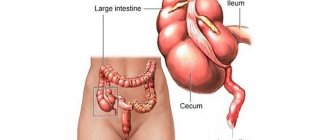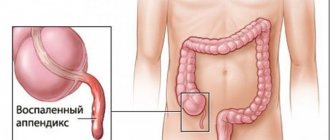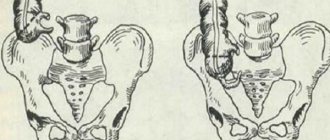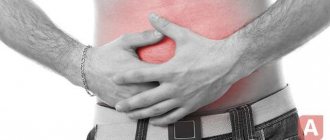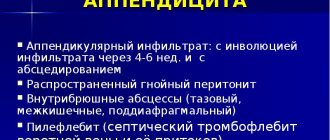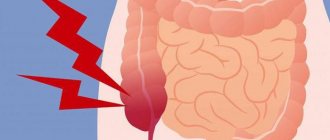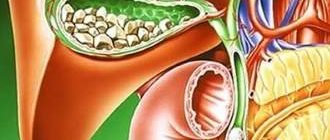A ruptured appendix due to acute or chronic appendicitis is the result of failure to provide emergency medical care within 1-2 days. In acute cases, it may take only 10-12 hours before rupture.
Rupture of the appendix is a serious complication of appendicitis, leading to the spread of purulent-infectious exudate beyond the vermiform appendix of the cecum, diffuse peritonitis. If your appendix bursts, you should immediately consult a doctor.
What is a ruptured appendix
Rupture of the appendix in acute appendicitis is one of the most severe surgical complications , when a purulent-infectious infiltrate penetrates beyond the cecum, fills the peritoneal cavity and contributes to the development of diffuse peritonitis. In fact, the wall of the appendix is perforated, and the contents flow out. Doctors often call the stage of appendix rupture peritonitis.
The high risk of mortality from appendicitis is due precisely to the development of inflammation of the subcutaneous fatty tissue of the peritoneum and abdominal organs, when even surgical intervention does not guarantee complete recovery. The consequences of a ruptured appendix and generalized peritonitis are always serious and require long-term rehabilitation and compliance with all medical recommendations.
Prevention
There are no specific rules for preventing purulent appendicitis, you only need to:
- give up bad habits;
- eat properly and balanced;
- do not overeat;
- to live an active lifestyle;
- in the early stages of development, eliminate those pathologies that can lead to such a disorder. To do this, you must regularly undergo a full medical examination.
Uncomplicated forms of purulent appendicitis have a favorable prognosis. In cases of complications, approximately 15% of all patients die.
Symptoms of a burst appendix
What symptoms occur when appendicitis bursts? The main symptom of acute appendicitis is acute pain in the lower abdomen on the right . It grows and can be localized near the navel or radiate across the entire surface of the peritoneum, into the dorsum and right hypochondrium.
The localization and wandering of the pain impulse depend on the topography of the appendix . From the onset of pain to signs of intoxication (vomiting, nausea, hyperthermia) can take from one to several hours. Other symptoms against the background of acute unbearable pain recede into the background or are not recorded when the patient is questioned about concomitant complaints.
Rupture with appendicitis is characterized by a sharp attack of pain with its further subsidence . Reducing pain and calming is an unfavorable prognostic sign, which indicates necrosis, gangrenous changes in the structure of connective tissue, and paralysis of nerve endings.
Note! You can also determine the moment of rupture by a feeling of warmth in the lower abdomen, as if a warm liquid is spreading inside. A day after the rupture, peritonitis develops, acute pain returns, and intoxication intensifies.
Stages of rupture
If the appendix bursts, the pathological process will go through several key stages. What are the stages of development of a ruptured appendix called? They are closely related to the peculiarities of the formation of diffuse peritonitis:
- Stage I - reactive . The patient complains of acute spasmodic pain in the lower abdomen, near the navel. Children often lose consciousness from painful shock. Vomiting, nausea, decreased temperature, pallor and sweating of the skin are observed.
- Stage II - toxic . The duration of the period varies from several hours to two days. Intoxication becomes severe, weakness sets in, blood pressure and pulse decrease, vomiting is constant, and dehydration develops. In children, the toxic stage without assistance often ends in death.
- Stage III - terminal . At a later stage, there is transient relief when symptoms subside. The stage is characterized by tissue necrosis and necrosis of nerve endings. The patient may lose consciousness or fall into a coma from severe intoxication.
At the third stage of rupture and advanced peritonitis, it is quite difficult to save the patient even with the full scope of medical intervention. Survival is also determined by the body's protective resources.
Can it burst without pain?
Acute appendicitis is always accompanied by pain that constantly increases . It is the pain syndrome that contributes to timely consultation with a doctor. The rupture itself may not be accompanied by pain; this moment can be missed due to severe background pain due to acute appendicitis.
Usually a doctor is consulted at the first stage of acute appendicitis , since it is impossible to endure and endure the pain for 24 hours. Sometimes patients harm themselves when they begin to relieve spasms and pain with painkillers.
Symptoms
Symptoms in adults and small children are almost the same. Signs of the purulent form may vary slightly depending on the stage of development of the disease.
The following are symptoms characteristic of all types of inflammatory process in the appendix:
- sharp, severe pain in the abdominal area, worsening in the evening and at night. The symptom does not always appear only on the right side; the process can be located in the middle of the peritoneum or on the back;
- Initially, the pain syndrome is diffuse in nature, forming in the abdominal area. The patient cannot point to the exact location, then the symptom moves to the right side of the peritoneum and is more pronounced when pressed with a finger;
- malaise, weakness, dizziness;
- bloating;
- nausea, vomiting;
- increase in body temperature;
- intoxication of the body;
- urination disorder, stool disorder;
- rapid heartbeat, clammy sweating;
- pus quickly spreads throughout the peritoneum, damaging nearby organs: kidneys, liver;
- in difficult situations, foci of necrosis appear - dark spots on the abdomen.
If such manifestations do not turn to a specialist, the consequences will not be the most pleasant.
Provoking factors
Main reasons for the breakup:
- long-term use of antispasmodic and painkillers;
- atypical location of the rudimentary process, its bend;
- injuries of the peritoneum and pelvic organs;
- concomitant inflammatory diseases of the intestinal tract.
Considering that rupture occurs as a result of long-term inflammation of the appendix , one of the factors is the lack of timely medical care for appendicitis.
Diagnostics
Diagnosis is based on a physical examination of the patient, an objective assessment of the condition , palpation of the abdominal cavity and pelvic organs. When palpating, there is pronounced pain in the area of pressure and stroking; when bending the right leg, it intensifies, and when lying on the left side, the pain becomes pressing.
Ultrasound of the peritoneum and pelvic organs and radiography are indicated as differential diagnostics. If the appendage of the cecum is atypically located and atypical symptoms develop, magnetic resonance imaging may be performed. Blood and urine tests are required.
In children
Symptoms and methods for diagnosing an acute surgical condition do not differ significantly . The psychological factor is of great importance. Children of early preschool and school age tend to hide symptoms due to fear of medical procedures.
Trouble is determined by moodiness, elevated body temperature, refusal to eat, and uncontrollable vomiting.
Important! Most complications are associated with appendicitis in children, since they are not able to objectively assess the degree of pain, its localization, and variations in pain during diagnostic procedures.
Etiology
In gastroenterology, there are several theories regarding the formation of such a disease.
In most cases, purulent appendicitis is formed precisely because of blockage of the lumen in the cecum, which is fully consistent with the mechanical theory. This can happen in the background:
- pathological influence of parasites;
- formation of fecal stone;
- tumor formation;
- hit by a foreign object;
- large pieces of rough food;
- lymphoid follicles.
Quite often, coprolites contribute to the development of suppuration during inflammation of the appendix, but they are not formed in the intestines of every person. Predisposing factors for the appearance of fecal stones is a lack of foods enriched with fiber or liquid in the diet. In some cases, this process is predisposed by the individual characteristics of the body.
Against the background of lumen obstruction, blood flow is disrupted, which entails the proliferation of pathogens and bacteria, which cause an inflammatory process, and in just a few days this can cause the development of severe complications that will lead to death.
According to the theory of the infectious origin of this form of inflammation of the cecal appendage, its sources can be:
- tuberculosis;
- typhoid fever;
- amoebiasis and other ailments.
Amebiasis is a possible cause of purulent appendicitis
As for the vascular and endocrine origin, there is a lot of controversy among clinicians. This is due to the fact that they are less common than the previous two theories. From this group of factors, only vasculitis is isolated, but this disorder is typical only for older people.
Treatment
Surgery is the only adequate treatment for ruptured appendix as a complication of acute appendicitis. The operation is urgent. Before it, an urgent ultrasound of the abdominal organs and a rapid blood test are prescribed, and the severity of the patient’s condition must be taken into account.
The consequences of a rupture are eliminated only by dissecting the peritoneum to inspect most internal organs for their antiseptics. Laparoscopy is rarely used due to the risk of leaving some of the spread exudate.
After cleansing the peritoneum of pus, it is recommended to install drainage structures to ensure unimpeded exit of the pathological mass. Solid suturing is performed only after determining complete dryness of the wound canal.
Stages of the disease
The onset of acute surgical pathology occurs with the catarrhal form. In the case when the pathogenic process intensifies, this leads to destructive changes in the appendix.
There are 4 stages of pathology development:
- Phlegmonous - appears in the first days of the disease. Any layers of the intestinal walls experience lymphocytic infiltration. The small appendage itself is filled with purulent dense contents. Inflammation is transferred to the peritoneum and serous walls. A person is suffering from intense pain. Temperature 38°C or more.
- Gangrenous - develops on 2-3 days. The intestinal wall undergoes diffuse infiltration. The mucosa is deprived of proper blood supply. Fragmentary death of the organ wall is noted. At this stage of gangrenous appendicitis, the pain decreases slightly, however, this does not indicate an improvement in well-being; the pathogenic process begins to progress with greater force. Signs of intoxication increase and fever occurs.
- Perforated appendicitis - rupture of the necrotic intestinal wall leads to the fact that purulent secretion enters the abdominal cavity. Which is the cause of peritonitis. Perforated disease differs from other forms in its early manifestations.
- Complicated - aggravation of the disease can cause the death of a person due to multiple organ failure, septic shock.
Purulent appendicitis is often the cause of the formation of infiltrate and abscess.
Postoperative period
Immediately after the operation, the patient is placed in a ward or intensive care unit until his condition stabilizes. Throughout the hospital period, the patient is monitored by medical personnel, antibiotic therapy (7-10 days) is prescribed to prevent relapse, and symptomatic treatment.
The duration of rehabilitation is determined by the initial condition of the patient upon admission to the surgical hospital, the addition of other complications, and the volume of surgical intervention. On average, hospital stay for a ruptured appendix ranges from 10 to 21 days.
Diet
On the first day after surgery, fasting and drinking plenty of fluids are recommended. If the patient is in a medically induced coma in the intensive care unit, nutrition is provided parenterally or through an esophageal tube.
In the next 24 hours, broths, slimy porridges, vegetable broths, and drinks are recommended . As the patient recovers, they are gradually transferred to their usual diet. The main indicator of recovery in terms of digestion is painless spontaneous bowel movements a few days after surgery.
Note! The purpose of food restrictions is to reduce the digestive load and internal aggressive factors.
Recommendations and restrictions
From the second day after surgery, physical activity, performing exercises in bed with limited walking , and following all medical recommendations are indicated. The sutures are removed on days 7-10, and discharge from the hospital is made on days 10-14 if there are no complications and the patient’s condition is stable.
Restrictions at the late recovery stage are imposed on:
- visiting a bathhouse, sauna;
- tanning procedures in a solarium;
- drinking alcoholic beverages;
- physical exercise.
The course of antibiotic therapy is stopped when leukocytes, the main sign of the inflammatory process, are no longer detected in blood and urine tests.
Note! Failure to comply with medical recommendations leads to disruption of the normal healing of the suture component, adhesions, inguinal-scrotal hernia in boys and men, and other consequences.
Complications and consequences
What happens if appendicitis bursts? A ruptured appendix is in itself a serious complication of acute appendicitis, but if timely assistance is not provided, the following may develop :
- abscess;
- diffuse peritonitis;
- appendicular infiltrate;
- pylephlebitis.
If the patient sees a doctor late, he dies from blood poisoning as a result of extensive sepsis . Advanced peritonitis almost always ends in death. If appendicitis ruptures during pregnancy, the woman needs emergency delivery by cesarean section.

